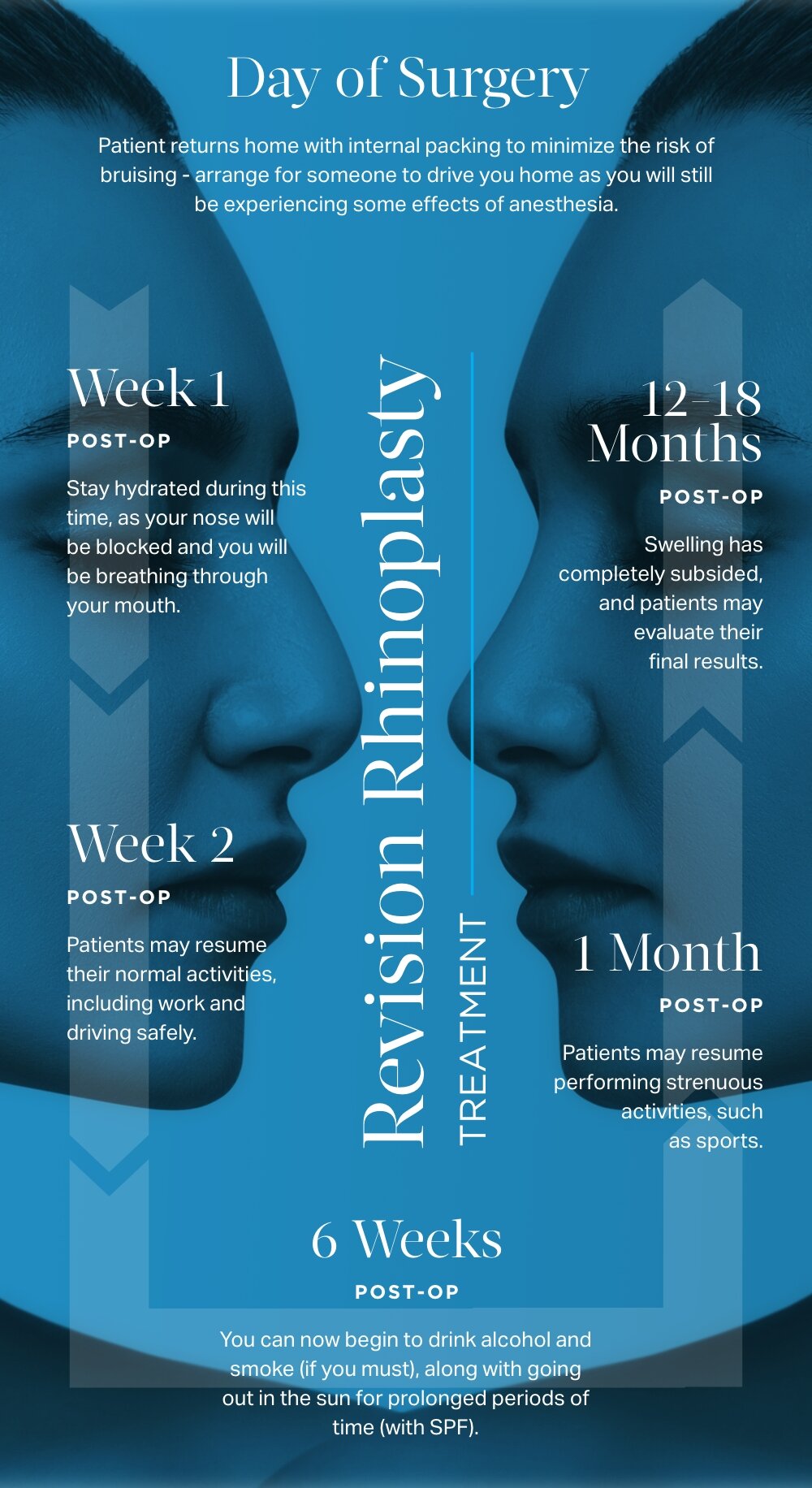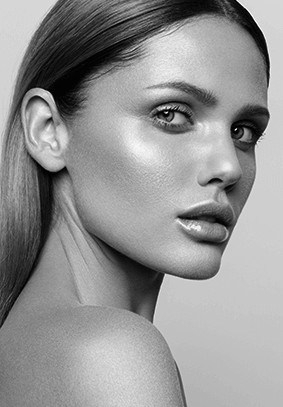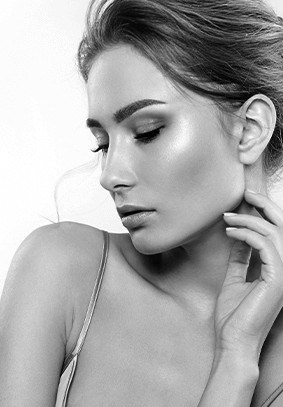-
 Price Starts at $14,999
Price Starts at $14,999
-
 Procedure Time 2-3 hours
Procedure Time 2-3 hours
-
 Recovery Time 2 weeks
Recovery Time 2 weeks
How Much Does a Revision Rhinoplasty Cost?
Rhinoplasty cost in Toronto varies according to the area of the nose and alterations required. Correcting previous nose surgery is a highly skilled task and, as such, the cost of revision rhinoplasty usually starts at $17,999 for a full nose job revision.
Revision Rhinoplasty Recovery and Timeline
Similar to a primary rhinoplasty, it can take up to 2 or more weeks for patients to recover from revision surgery.

Day of Surgery: Patient returns home with internal packing to minimize the
risk of bruising. You will be impaired from the anesthesia and thus unable to drive, so arrange for someone to bring you home.
Week 1: Stay hydrated during this time, as your nose will be blocked and you will be breathing through your mouth.
Week 2: Patients may resume their normal activities, including work and driving safely.
Week 3: You can now begin to drink alcohol and smoke (if you must), along with going out in the sun for prolonged periods of time (with SPF).
Month 1: Patients may resume performing strenuous activities, such as sports.
Month 12-18: Swelling has completely subsided, and patients may evaluate their final results.
How Long Does it Take to Perform a Revision Rhinoplasty?
Revision rhinoplasty can be performed in 2-3 hours but in more severe cases, where the nose’s underlying framework needs to be resculpted, the procedure can take several hours.
What is a Revision Rhinoplasty?
Revision rhinoplasty is a procedure aimed at correcting or improving the results of a previous rhinoplasty surgery. It involves reconstructing and reshaping the nose to achieve a more satisfactory outcome. Due to the complex anatomy of the nose, this surgery requires exceptional precision. The experienced cosmetic surgeons at TPS in Toronto are known for their expertise in facial plastic surgery and can perform these corrections to restore facial harmony.
Am I a Good Candidate for Revision Rhinoplasty?
If you’ve been left with poor aesthetic results or a nose that no longer functions properly after a nose surgery, revision surgery is a possibility. Before undergoing a secondary rhinoplasty, your nose should be healthy and fully healed from the initial procedure. It can take up to 2 years for the results of their first surgery to become apparent.
Revision rhinoplasty is also a procedure that can correct damage to the nose inflicted by an accident or sports injury.
While there are no specific traits that make a good candidate for revision rhinoplasty, there are certain attributes that are preferred. These include a well-defined bone structure, good physical health and sound expectations of the results revision rhinoplasty can achieve.
4 Benefits of Revision Rhinoplasty
Reverse Unsatisfactory Results
Correct visible deformities caused by a poorly performed primary rhinoplasty procedure.
Boost Confidence
Our specialist cosmetic surgeons can boost your diminished confidence after your first rhinoplasty.
Health-Related Issues
Fix any health-related issues that stemmed from your previous surgery.
Dramatic Alterations
Should the nose have significant alterations from its original state, an implant will be installed to correct this issue.
Revision Rhinoplasty Risks & Complications
Like every procedure, revision rhinoplasty comes with a small chance of potential complications. To minimize the likelihood of complications, the best thing to do is to select a trusted, experienced surgeon. The team at Toronto Plastic Surgeons has years of experience performing rhinoplasty revisions. Significant complications are uncommon and, in the rare event they occur, are expertly managed.
- Nose Bridge Deformity: Small irregularities that may occur to the nose bridge can be adjusted with simple molding.
- Scarring: The scar from the nasal tip to the base usually clears but can sometimes remain visible.
- Breathing Difficulty: Making the nose smaller can risk breathing difficulty. A follow-up procedure to increase airflow may be required to compensate.
- Infection: The Toronto Plastic Surgeons take every precaution possible to avoid the already small chance of infection.
Different Types of Revision Rhinoplasty Surgery
There are two different approaches for revision rhinoplasty: closed (endonasal) and open (external).
Closed
Uses internal incisions and is often used for secondary correction of the bridge and asymmetries of the lower third of the nose.
Open
Uses external and internal incisions. The approach of choice for correcting revisions that involve the nasal tip and nostrils.
Revision Rhinoplasty Alternatives
Injection rhinoplasty is a non-surgical option to surgical secondary rhinoplasty. This popular technique also called the “5-minute nose job” is very effective in correcting a bump on the bridge, indentations, a crooked nose, or an inadequate dorsal bridge.
The nose can look great in a day, but the results only last for approximately one year, then need to be repeated.
How is a Revision Rhinoplasty Performed?
A revision rhinoplasty procedure is performed under general, or local anesthesia with IV sedation. The best type of anesthesia will be determined based on previous medical history and current prescriptions.
At your initial consultation, computer-simulated imaging is used to give you and the surgeon an accurate representation of the likely outcome. During revision surgery, cosmetic surgeons reconstruct and reshape the nose to alter the unsatisfactory outcome of your previous nose job. In extreme cases where the entire structure of the nose must be rebuilt, surgeons use pieces of cartilage from a patient’s body as implants. These pieces of cartilage are typically found in the nasal septum, ear, or rib.
Preparing for a Revision Rhinoplasty
- No smoking 2 weeks prior to and after the procedure
- No aspirin-containing drugs 2 weeks prior to surgery.
- No alcohol 1 week prior.
- Don’t eat or drink on the day of surgery.
- Thoroughly wash your face the day of the surgery.
- Stock up for home recovery period (pre-made meals, antibacterial soap, ice packs etc)
- Entrust a friend or family member to take you home from surgery.
What to Expect Post Revision Rhinoplasty Surgery?
Most patients will go home following their procedure with internal packing in the nose to minimize the risk of bruising, and a cast on the external portion of their nose.
The two days after surgery have the highest level of discomfort. Pain medication may be prescribed, and a cold compress to the cheeks can be used to manage the swelling. Patients are advised to keep the head elevated while resting and sleeping for at least 1 week to minimize bruising and swelling.
Revision Rhinoplasty Recovery
Day of Surgery: The patient returns home with internal packing in the nose to minimize the risk of bruising.
Day 2: Return to light activities such as walking.
Day 5-7: Packing out (if used), cast off and external sutures out.
Week 2: Most of the swelling has subsided. Patients resume normal activities, including work.
Month 1: More strenuous activities, such as sports and heavy lifting can be resumed.
Month 18-24: Swelling is completely subsided and the final results are now visible.
Why the Toronto Plastic Surgeons?
If you are unhappy with your first rhinoplasty, we know you’ll want to enlist a trustworthy, experienced revision rhinoplasty surgeon for the revision procedure. Revision procedure is a highly technical and challenging surgery that requires a surgeon with meticulous attention to detail.
By using the latest technology and techniques, The Toronto Plastic Surgeons are well-versed in rhinoplasty correction procedures. Our renowned surgeons customize every procedure to the specific needs of the patient and provide patients with long-lasting results.
Toronto Plastic Surgeons has performed thousands of rhinoplasty procedures, is one of Canada’s most reputable plastic surgeons. He trained in cosmetic rhinoplasty and cosmetic plastic surgery of the face with the Paris plastic and craniofacial surgeon Dr. Danial Marchac, and was named one of the top cosmetic surgeons in the world by W magazine.
FAQ
We’ve performed many revision rhinoplasty procedures over the years and in this time we’ve answered many questions and queries from patients-to-be. Here are the answers to some of the most commonly asked revision rhinoplasty questions. During your initial consultation, you’ll be able to ask any of your personal questions.
Is Getting a Revision Rhinoplasty Painful?
General anesthesia will be used and no discomfort will be felt during the revision rhinoplasty procedure itself. In the days following the procedure, patients will notice swelling and some discomfort but this will subside and there will be no long-term pain.
How Long Should I Wait to Receive Revision Rhinoplasty?
After your original nose job surgery, you should wait anywhere between 1 and 2 years before proceeding with a revision rhinoplasty. This gives your nose enough time to heal before undertaking another procedure.
If I Break My Nose After Having Rhinoplasty, Do I Need Revision Surgery?
Revision rhinoplasty surgery can smoothen sharp angles, correct deformities, and realign the nose after a severe nose break. By restoring symmetry and removing irregularities, the appearance of a broken nose can be completely fixed.

